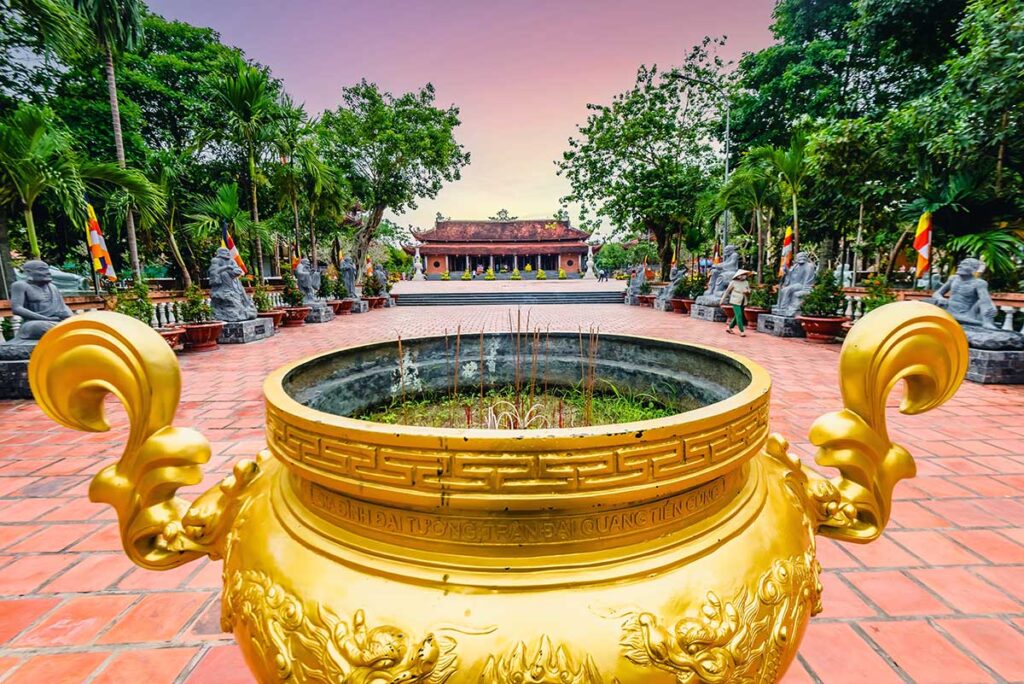What is Can Tho’s Truc Lam Phuong Nam Zen Monastery?
Location and Scenery
Truc Lam Phuong Nam Zen Monastery is located in My Khanh Commune, about 15 kilometers from Can Tho city center in the Mekong Delta. The complex covers nearly four hectares, making it the largest Zen monastery in the region. Surrounded by lotus ponds, shady courtyards, and red brick walkways, the grounds are designed to create a calm retreat away from the bustle of Can Tho’s markets and busy streets.
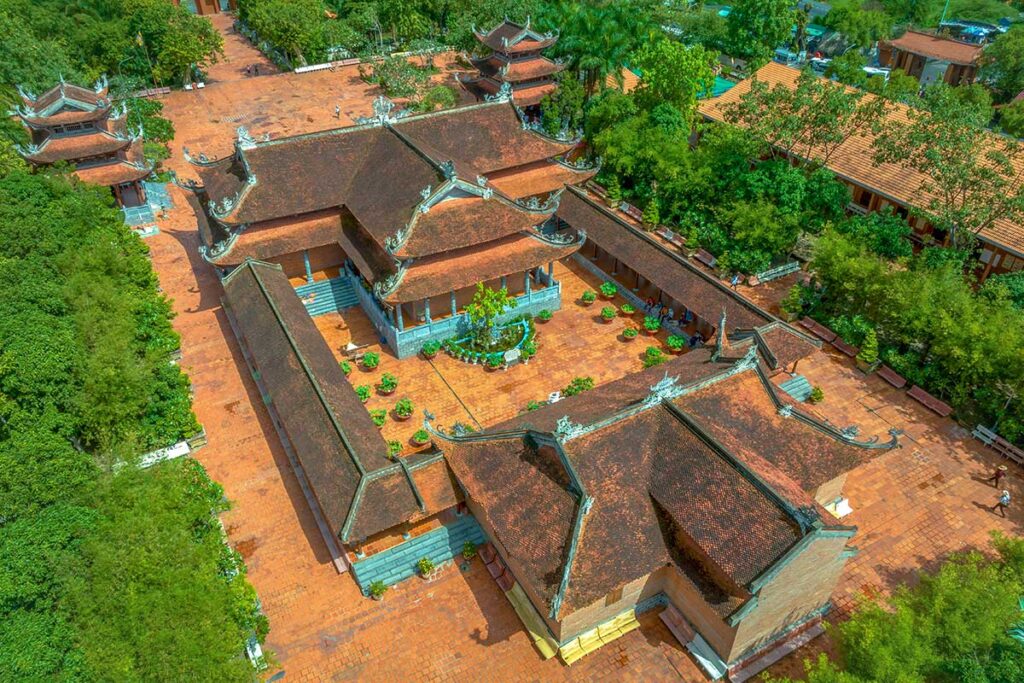
Construction and History
The monastery is a relatively new site. Construction started in July 2013 and was completed in May 2014, with the official inauguration led by the Buddhist Sangha of Can Tho. Its design was inspired by the Ly and Tran dynasties, periods when Vietnamese Buddhism flourished. Key features such as the eight-roofed main hall, the ancestral house, and the bell and drum towers echo traditional Vietnamese architecture, while modern materials like imported hardwood give the buildings a grand scale.
Purpose and Role Today
Although not an ancient temple, Truc Lam Phuong Nam plays an important role in the region. It is part of the Truc Lam Zen lineage, a Vietnamese Buddhist tradition that emphasizes meditation and simplicity, founded by King Tran Nhan Tong in the 13th century. Today, the monastery functions both as a place of worship and as a cultural site open to visitors. Local Buddhists come for daily prayers and ceremonies, while travelers can explore the spacious grounds, admire the architecture, and enjoy a quiet break during a trip through Can Tho.
Highlights of visiting Truc Lam Phuong Nam Zen Monastery
1. Main Hall (Đai Hùng Buu Đien)
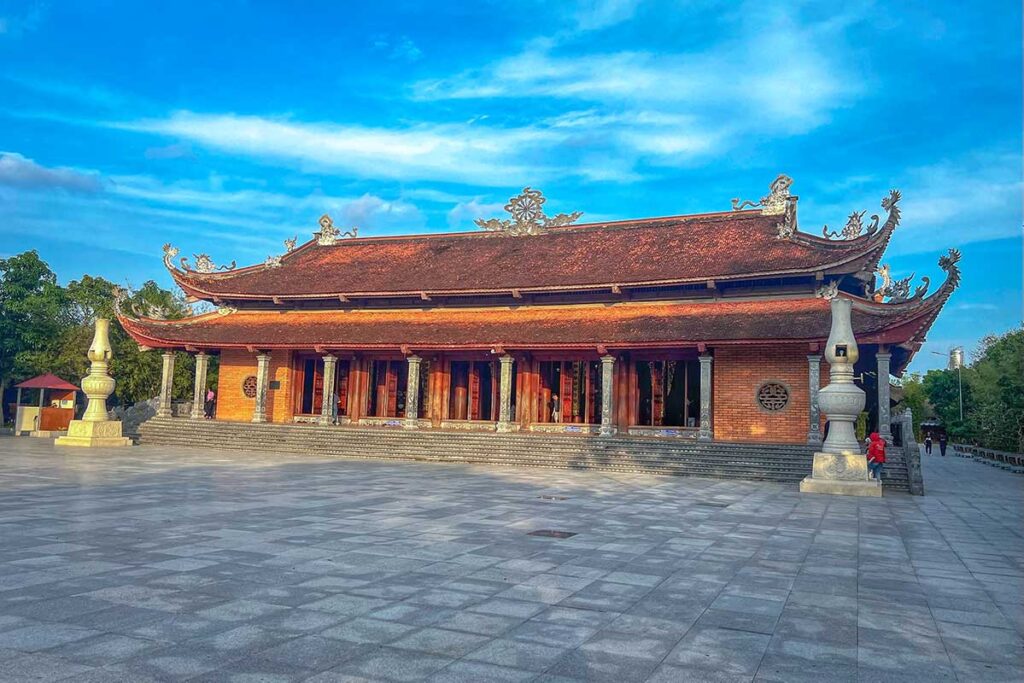
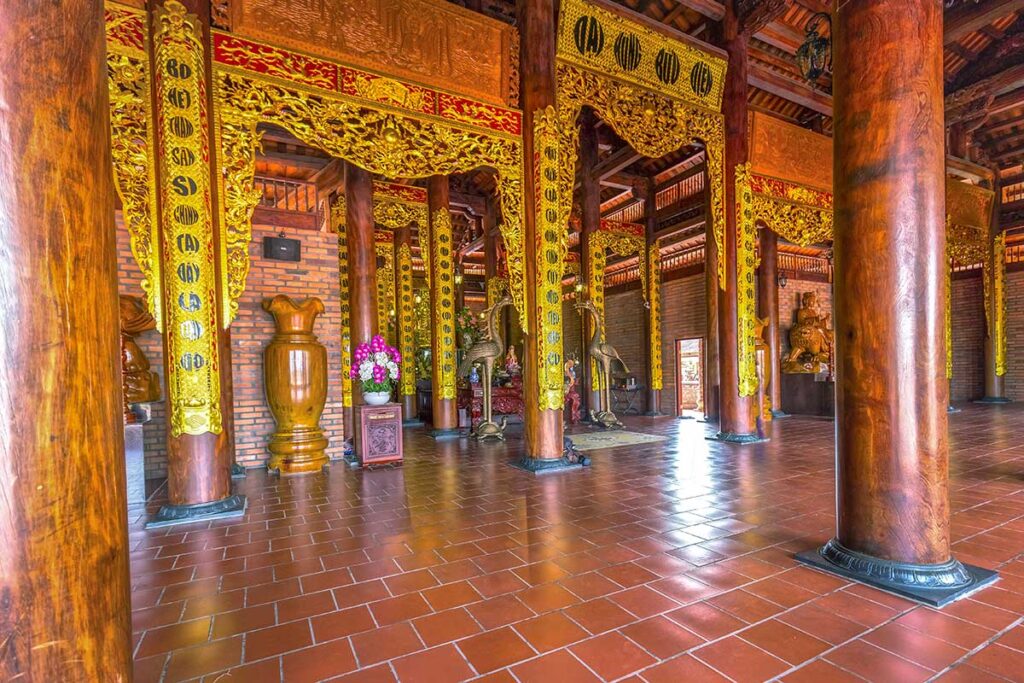
The main hall is the most impressive building in the complex. At its center sits a 3.5-ton bronze statue of Shakyamuni Buddha in a meditative pose, flanked by statues of Bodhisattvas. The structure itself reflects Tran dynasty architecture, supported by massive ironwood pillars that give the space a solemn and dignified atmosphere.
2. Ancestral House (To Đien)
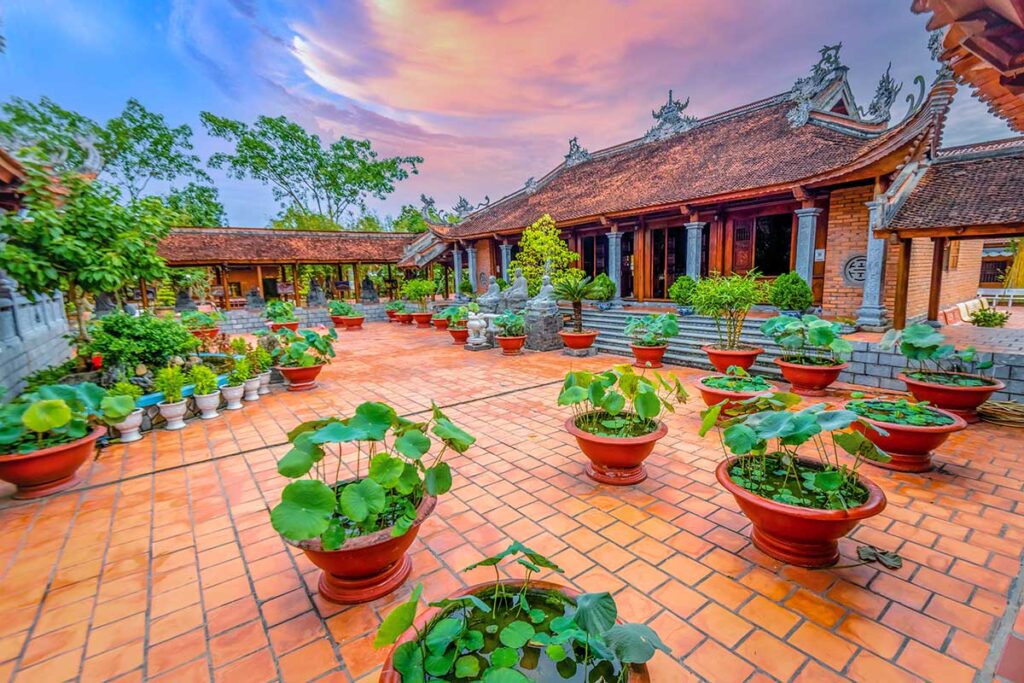
Behind the main hall lies the ancestral house, dedicated to Bodhidharma and the three patriarchs of the Truc Lam Zen school. Here you’ll find wooden statues carved from Du Sam wood, some said to be from trees around 800 years old. This gives the space a different, more intimate atmosphere compared to the grandeur of the main hall.
3. Bell & Drum Towers
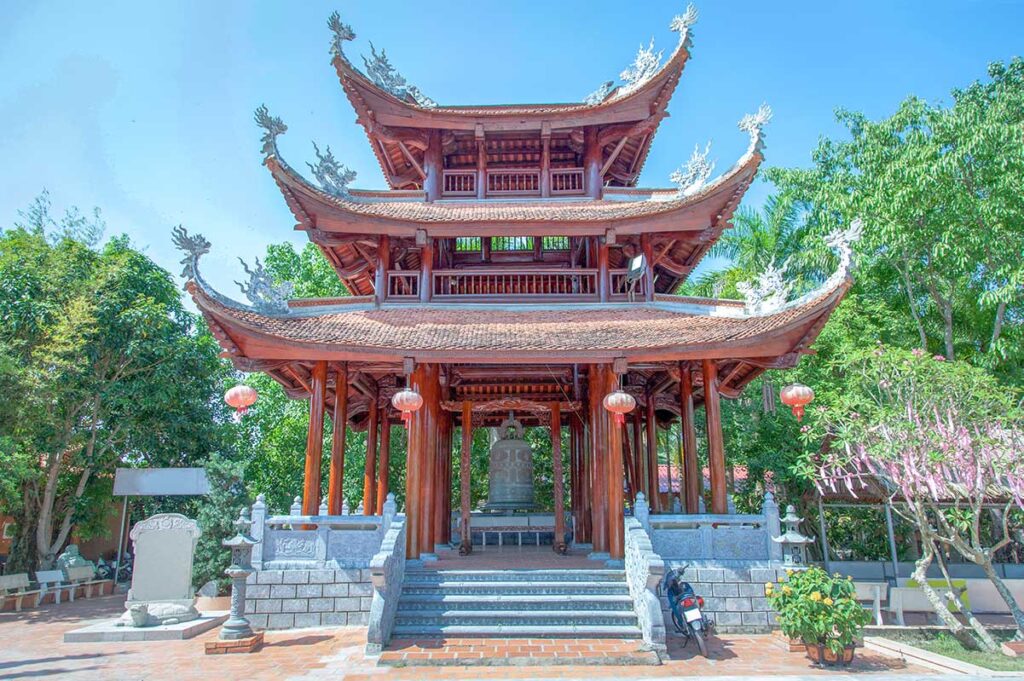
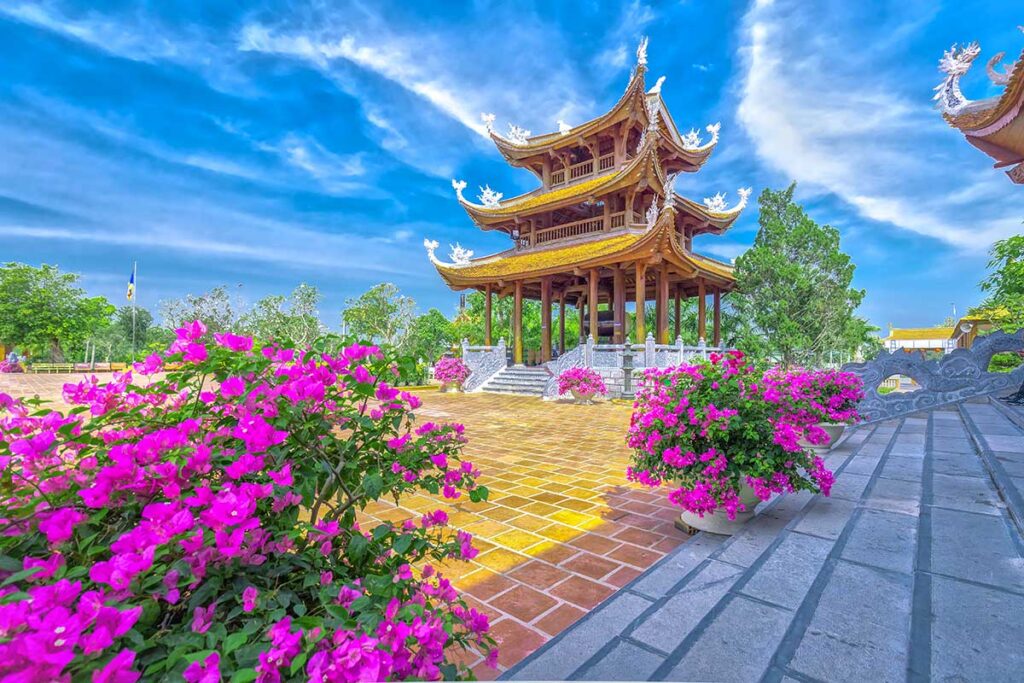
On either side of the main hall stand the bell and drum towers. The great bell, known as Dai Hong Chung, weighs 1.5 tons and is rung during ceremonies. Their design was modeled after the famous Keo Pagoda in northern Vietnam, adding a touch of traditional northern architecture to the Mekong Delta setting.
4. Statues & Courtyard
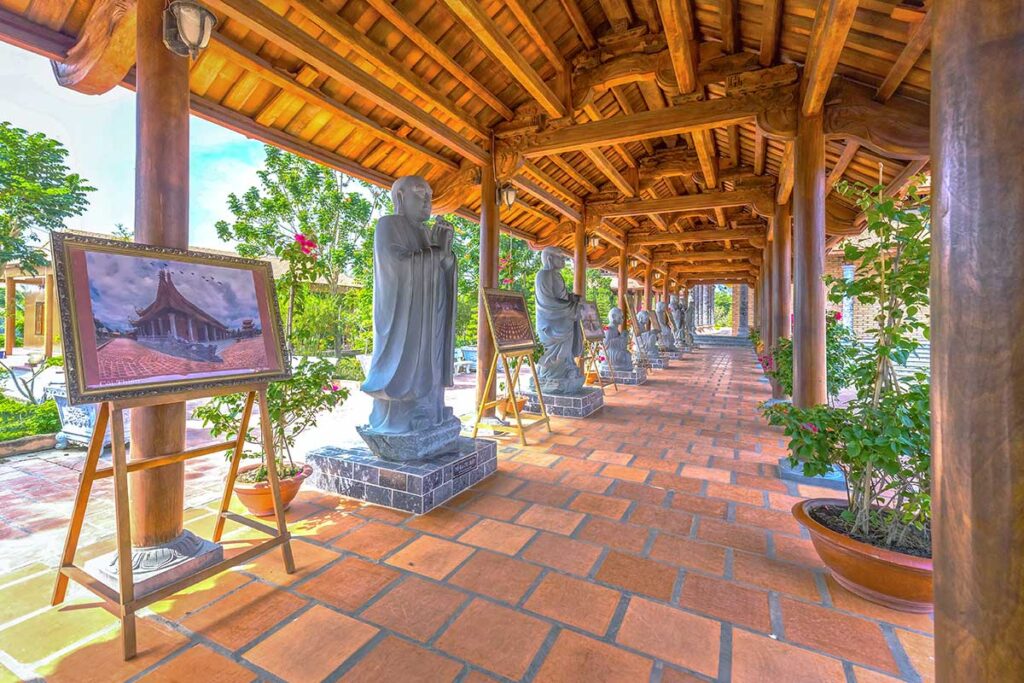
The courtyard and walkways are lined with stone statues, including an avenue of arhats and a large smiling Maitreya (Di Lac). Around the ponds you’ll also see Guan Yin figures, lotus blossoms, and even koi fish and turtles, which add to the feeling of peace. It’s an area where visitors tend to linger, whether for quiet reflection or photography.
5. Traditional Vietnamese Architecture
Throughout the complex, the architecture blends styles from the Ly and Tran dynasties. Red brick courtyards, curved tiled roofs, and carved wooden beams give the monastery a distinctly Vietnamese identity, even though it was only built in the last decade. The Tam Quan entrance gate is especially striking, decorated with motifs such as dragons and the Dharma Wheel.
6. Meditation & Spiritual Atmosphere
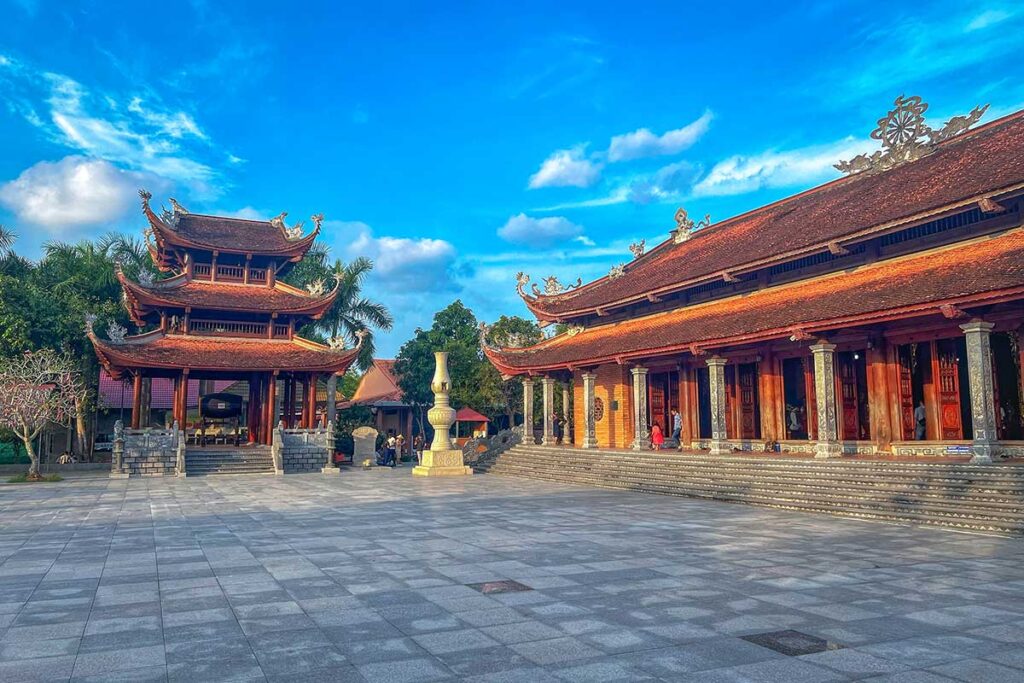
Beyond the physical structures, many visitors value the calm atmosphere here. The monastery is active, so you may hear chanting or bells if you visit during a ceremony. At quieter times, the open courtyards and shaded walkways provide space for reflection—something that can feel rare in the otherwise lively city of Can Tho.
7. Other Facilities
The complex includes additional spaces such as a library, a vegetarian dining hall, and a guest house. There is also a small clinic offering free traditional medicine on certain days of the week, mainly serving local people. While these areas may not be the focus for most tourists, they highlight the monastery’s role as a living community rather than just a sightseeing stop.
Location and How to get there
Where is the Monastery?
Truc Lam Phuong Nam Zen Monastery is located in My Khanh Commune, Phong Dien District, about 15 kilometers south of Can Tho city center. Can Tho itself is the main hub of the Mekong Delta and is well connected by road, bus, and flights. Travelers often reach Can Tho from Ho Chi Minh City (about 3–4 hours by car), but it’s also accessible from other regional destinations such as Chau Doc, Tra Vinh, and Soc Trang. From the city center, the monastery is a straightforward trip and can be visited as part of a day exploring the countryside around Can Tho.
Transport options
- Taxi or Grab – The simplest way to get there. A car ride from Can Tho city center takes around 25–30 minutes.
- Private car with driver – A good choice if you’d like to combine the monastery with other sights in the area, such as fruit orchards or small canals.
- Private tour – Similar to hiring a car, but with a guide who can give more context and tailor the itinerary to your interests.
- Motorbike – Roads are flat and manageable, and it’s a common option for those comfortable driving in Vietnam. Still, experience and a valid license are recommended.
- Cycling – If you’re staying in a nearby homestay or in Phong Dien’s countryside, cycling is a pleasant way to reach the monastery. The quiet rural roads make the ride enjoyable, though less practical if coming from central Can Tho.
Practical visiting information & Tips
Opening Hours & Entrance Fee
The monastery is open daily from dawn until dusk, and entry is free. You may see donation boxes around the grounds if you’d like to contribute, but there is no obligation.
Dress Code & Etiquette
As with any Buddhist site in Vietnam, dress modestly—covering shoulders and knees is recommended. Shoes should be removed before entering the main hall. The atmosphere here is calm, so keeping voices low and avoiding behavior such as climbing on statues is important.
Best Time to Visit
For the most comfortable visit, aim for morning or late afternoon, when the light is softer and temperatures are cooler. Weekends and Buddhist ceremonies draw larger crowds, which can make the site lively and interesting, but less quiet. The dry season (November–April) is easiest for exploring, while the rainy season (May–October) brings greener scenery and blooming lotus ponds, though you’ll want to bring a rain layer.
Facilities & Services
The complex has a spacious parking area for motorbikes, cars, and even larger vehicles. A vegetarian restaurant operates on-site, mainly serving simple meals for visitors and worshippers. Instead of entrance fees, you’ll find small donation boxes near halls and shrines. Basic facilities are available, but don’t expect a tourist infrastructure beyond what’s needed for local use.
Nearby places to combine
The monastery fits well into a day of sightseeing around Can Tho’s countryside. Nearby options include:
- My Khanh Tourist Village – a family-friendly spot with gardens, animals, and local-style houses.
- Cai Rang Floating Market – best visited early in the morning by boat, then combine with the monastery later in the day.
- Organic cacao farm – a small local stop about 10 minutes away where you can learn about cacao processing.
- Phong Dien fruit orchards – rural gardens where visitors can taste tropical fruit and enjoy the scenery
Is Truc Lam Phuong Nam Zen Monastery worth visiting?
Truc Lam Phuong Nam Zen Monastery is worth a stop if you’re already in Can Tho or nearby. The grounds are spacious, peaceful, and well-maintained, making it a pleasant place to walk around, take photos, or enjoy a quiet break from the city.
That said, it’s important to keep expectations realistic. The monastery was only built in 2013–2014, so it doesn’t have the centuries of history you’ll find at older temples in northern or central Vietnam. If you’re looking for deep historical significance, this may feel more like a cultural landmark than a must-see. Still, as part of a broader Mekong Delta trip—especially combined with floating markets, orchards, or countryside stops—it adds variety and balance to the experience.
